Marseille is getting ready to host the sailing competitions during the Paris 2024 Olympic Games. The city is currently building a state-of-the-art nautical stadium that will serve as the venue for these events. The project, located at Roucas Blanc Bay, emphasizes sustainable practices, including the use of durable and low-carbon construction materials. We had the opportunity to visit the construction site alongside Nicolas Chicouras, Project Director at Travaux du Midi (part of Vinci Construction Group), just before the final buildings were delivered.
Our video report
The Olympic Games will take place in France from July 26th to August 11th, 2024. While most of the events will be held in Paris, the football and sailing competitions will be hosted by Marseille.
In preparation for the sailing events, the second-largest city in France is constructing a new Olympic nautical stadium at Roucas Blanc Bay in the southern part of the city. The construction, which began in January 2022 and is estimated at 44 million euros, is still underway.
Once completed, the state-of-the-art stadium will consist of six buildings, including one refurbished structure (covering an area of 7,000m²), 17,000m² of outdoor spaces, and a fully redesigned nautical basin spanning over 5 hectares.


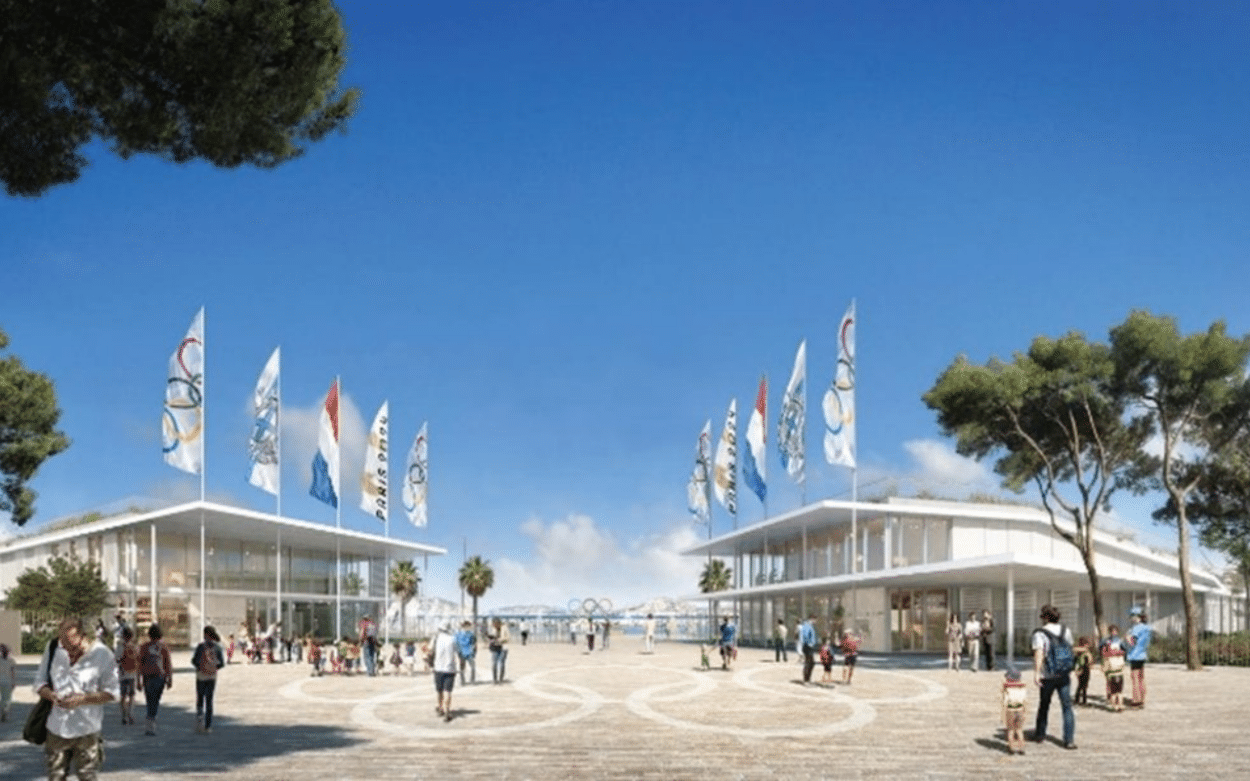
Five New Buildings and One Renovation
Travaux du Midi (Vinci Construction) is responsible for the construction work, collaborating with the architectural duo Rougerie+Tangram and the Carta Associés agency.
The first building, covering an area of 3,800m², was delivered by Travaux du Midi in February of this year. It is already housing the “Pôle France Voile,” where athletes will undergo training in preparation for the Olympic Games.
Buildings two, three, and four will accommodate municipal offices, the Marseillais Sailing Center (CMV), and the maritime department. The fifth building, with a more technical focus, will serve as a workshop for boat repairs and maritime structures. Lastly, the sixth building is a renovation project intended for the maritime police (USPL).
The delivery of buildings two and three by Travaux du Midi is scheduled for June 21st. The remaining buildings must be completed by July 8th, the start date for a full-scale test of the facilities, ensuring everything is ready for 2024.
On the maritime side, Vinci Construction Maritime Fluvial and Spac (Colas Group) are in charge of the redevelopment of the nautical basin at Roucas Blanc Bay.
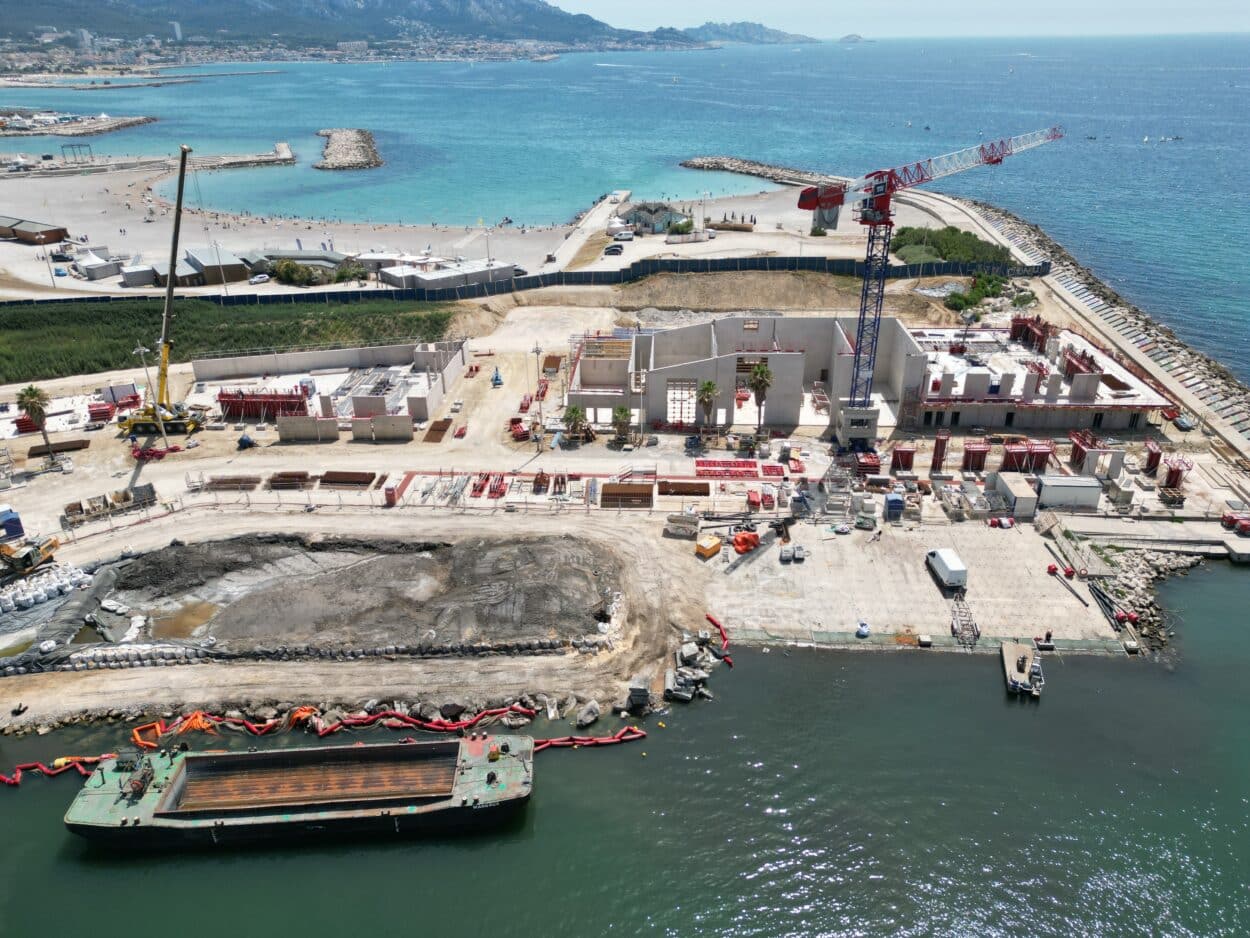


A Low-carbon Concrete Structure
During our visit to the construction site, we spoke with Nicolas Chicouras, Project Director at Travaux du Midi, to learn more about the eco-friendly construction methods employed in these future buildings.
The project aims to achieve two eco-construction certifications, which required the teams to work with environmentally-friendly materials and processes, such as low-carbon concrete.
“We are working with conventional structures, classic cast-in-place reinforced concrete, formwork concrete, low-carbon concrete with a specific characteristic. We poured concrete with triple heights of formwork concrete. We worked on raw solutions, as you can see, the buildings have a raw exterior, and many areas inside as well. What pollutes the least is what we ultimately don’t use. So that’s what we tried to do by limiting surface treatments. We used a low-carbon concrete, which is a bit special because we substituted blast furnace slag with activated clays to further reduce carbon emissions.”
Low-carbon concrete is concrete in which the associated CO2 emissions during production are reduced. In concrete manufacturing, it is the limestone that needs to be heated to very high temperatures that is the main source of carbon dioxide emissions. The challenge is to replace a portion of this limestone.
To achieve this, it is possible to use residual minerals from the industry, such as blast furnace slag, or in the case of this construction site, clay. Depending on the proportions used, the concrete can have a carbon footprint up to 70% lower than that of traditional concrete, without compromising technical performance.


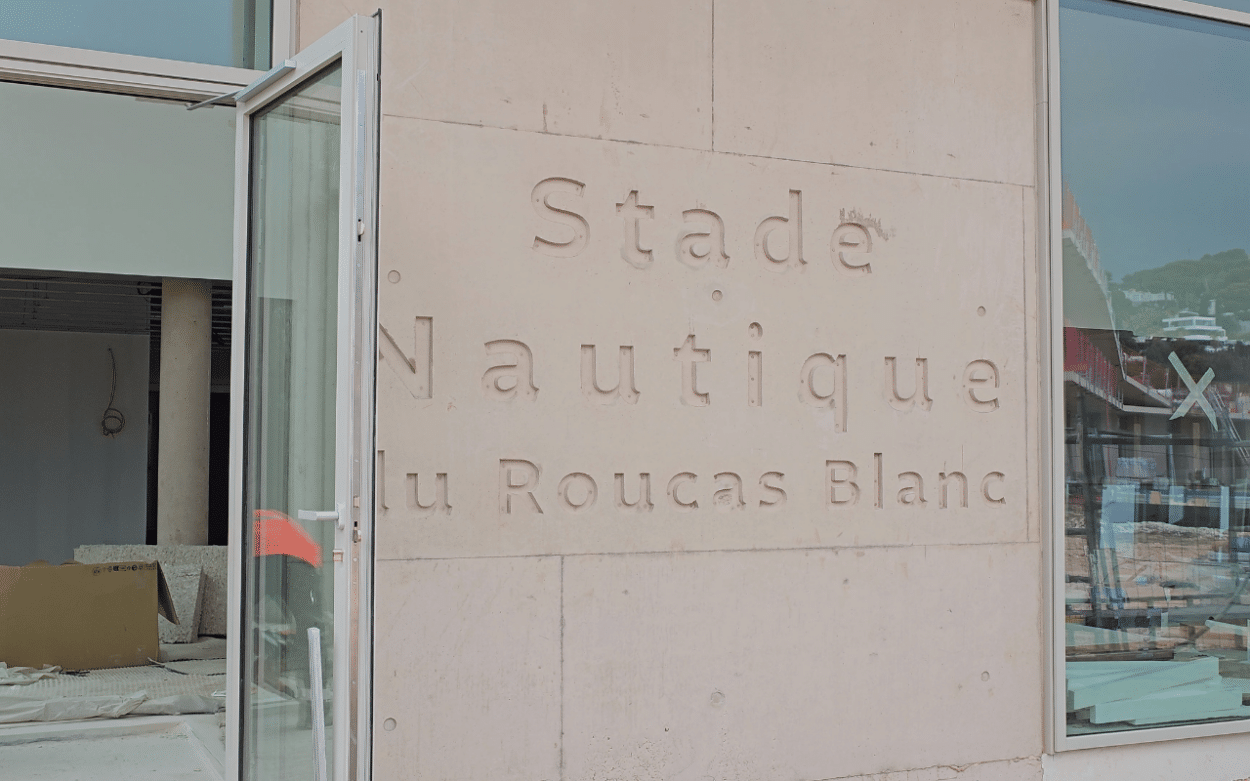
Resisting Marine Agressions
Less chemically treated, low-carbon concrete also offers better resistance to marine aggressions, which is advantageous for a site naturally exposed to sea spray and wind.
“We have steel coverings that are thicker than conventional coverings. We have five centimeters of concrete covering, which is quite significant. We have very specific concretes to resist marine aggressions and sea spray, and then we have a structure that is left with a raw finish because it is designed to withstand these specific conditions. At first, the possibility of using wood as a construction material was mentioned. However, the client expressed doubts. Wood is not considered as a local material for construction. And then, the site itself is highly exposed to harsh weather conditions. The building you see behind me is constantly subjected to strong sea spray. Therefore, it was necessary to select materials that are extremely resistant and durable. In this case, wood was not chosen as the preferred option.”
The use of raw concrete blends well with the surrounding landscape with its light beige tones. The buildings are meant to remain after the Olympic Games, so they needed to be harmoniously integrated into the mineral aesthetic of the site.
“The decision to incorporate raw concrete into the design was a deliberate choice, influenced by the presence of the Roucas Blanc site. The term “Roucas Blanc” refers to the “White Rock” in Marseille dialect, reflecting the local geography. Taking inspiration from the Marseille coastline, specifically the Corniche Marseillaise, the buildings feature a distinctive façade design resembling the coastal landscape. The aim was to create a cohesive architectural ensemble, with most buildings being of relatively low height. However, Building 1, the French sailing center, required taller hangars to accommodate masted boats, resulting in structures over eleven meters high. Despite this variation, the overall focus was on seamlessly integrating the project into the site and minimizing any disruption caused.”



Biosourced Materials
Emphasis was also placed on the use of bio-sourced materials. Hemp, in particular, was chosen for thermal insulation. For the flooring, linoleum made from flax fibers will be used.
Vegetated roofs with only local plant species are planned to enhance the thermal inertia of the buildings.
The orientation of the buildings was also carefully considered based on their exposure to sunlight.
“The buildings feature sunshades, which have been designed to allow sufficient solar gain in winter to reduce heating needs while limiting excessive heat gain in summer to minimize the need for air conditioning. The entire project was modeled in three dimensions to analyze solar paths, optimal exposures, and sunshade orientations.”
Technical Challenges
One of the main technical challenges involved soil reinforcement. The site of the future nautical stadium is located on the fill of the former Marseille metro, necessitating an increase in soil-bearing capacity. The solution consisted of a controlled module column system made of concrete to improve soil rigidity and enable the support of ground-bearing slabs.

To reduce the carbon footprint of the project, Solideo, the organization overseeing the Olympic facilities, also mandated that 90% of the existing elements on the site be repurposed.
“We are building on the public maritime domain and we had minimize our footprint. We maximized the valorization of waste materials. We also did significant work before arriving at the site. There were existing structures and we made every effort to repurpose what was already there. For example, the base camp is made up of refurbished Algeco containers that were on the site. We also utilized existing structures and recycled the exterior cladding from the pre-existing buildings, incorporating them into the project.”
The team also has the objective to maintain the permeability of the soil.
“We measured the soil permeability before the project commenced and ensured that the implementation of our project would not degrade this aspect. This involved using permeable materials such as asphalt and stabilized, draining soils. We maximized the green spaces to ensure that the site we restore does not channel or concentrate runoff more than it did before.”
Maritime Side
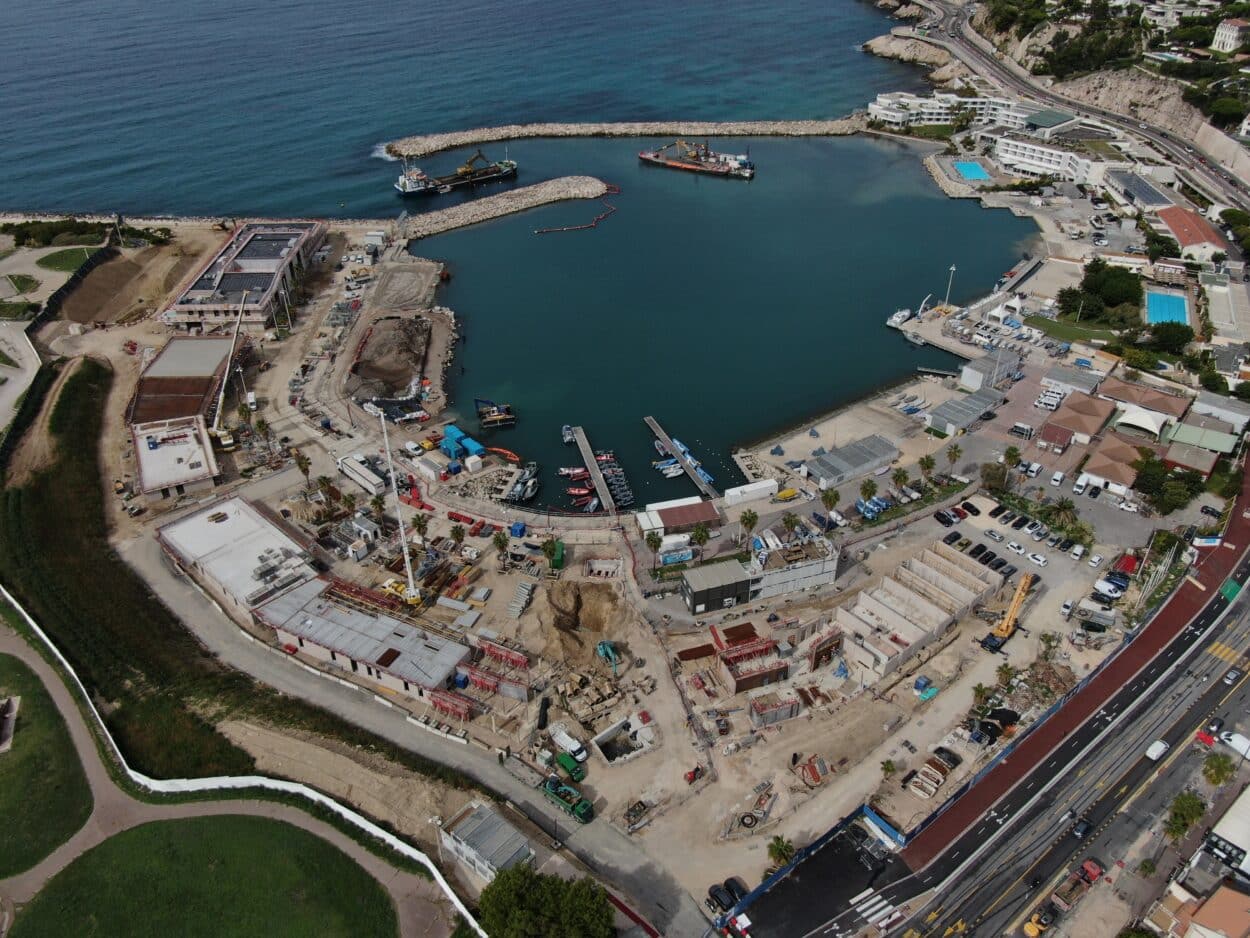
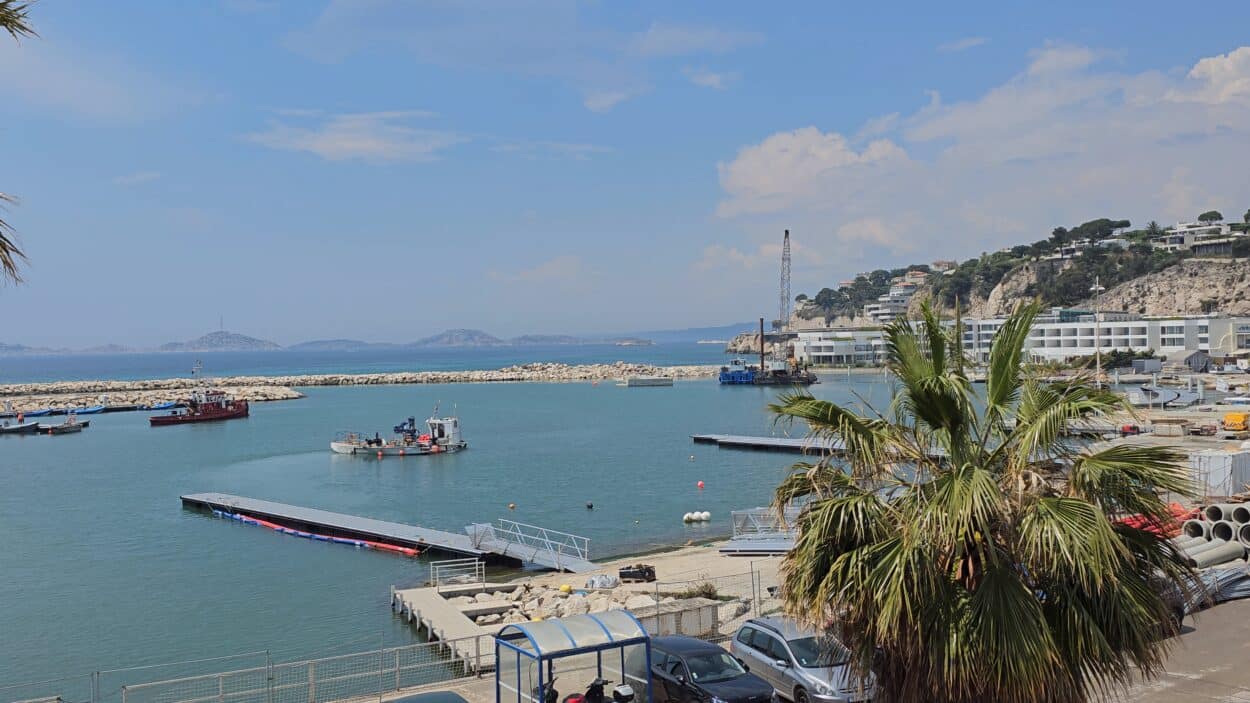

The redevelopment of the nautical evolution basin required three distinct steps on the maritime front. In the initial phase, Vinci Construction Maritime Fluvial took the lead, while the subsequent two phases were overseen by Spac, a subsidiary of the Colas Group.
“The first step was dredging the bay, removing over 22,000 cubic meters of materials through pumping and dredging. The goal was to remove sediment and ensure a water depth compatible with the sailing events during the Olympics. The second significant work involved constructing dikes to protect the Roucas shoreline. The third task was the creation of what is known as avivement culverts. These culverts, located under the existing dikes, are designed to create underwater currents to limit bay siltation. This allows water currents to enter and exit the bay, preventing excessive silting.”
After the Olympics, this basin could even become a fish nursery.
The full-scale rehearsal of the events will take place from July 9th to July 16th. This “test event” will provide athletes an opportunity to test the race areas and allow organizers to ensure that everything is technically ready for 2024.
The sailing competitions will take place from July 28th to August 8th, 2024. A total of 330 athletes from 60 countries are expected to participate.











